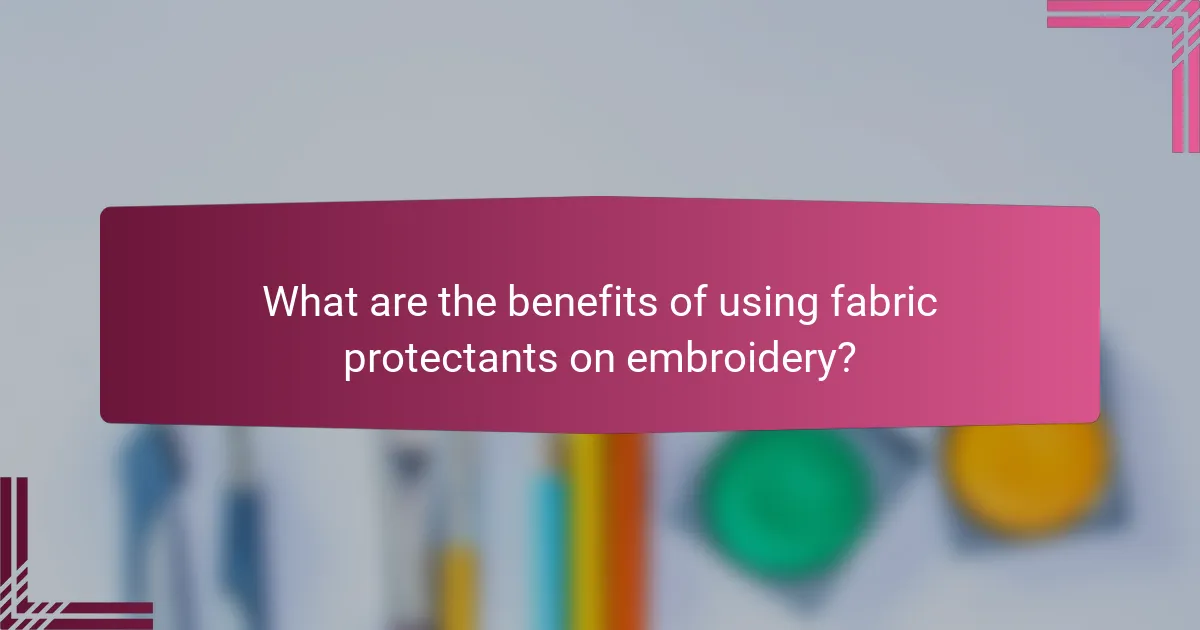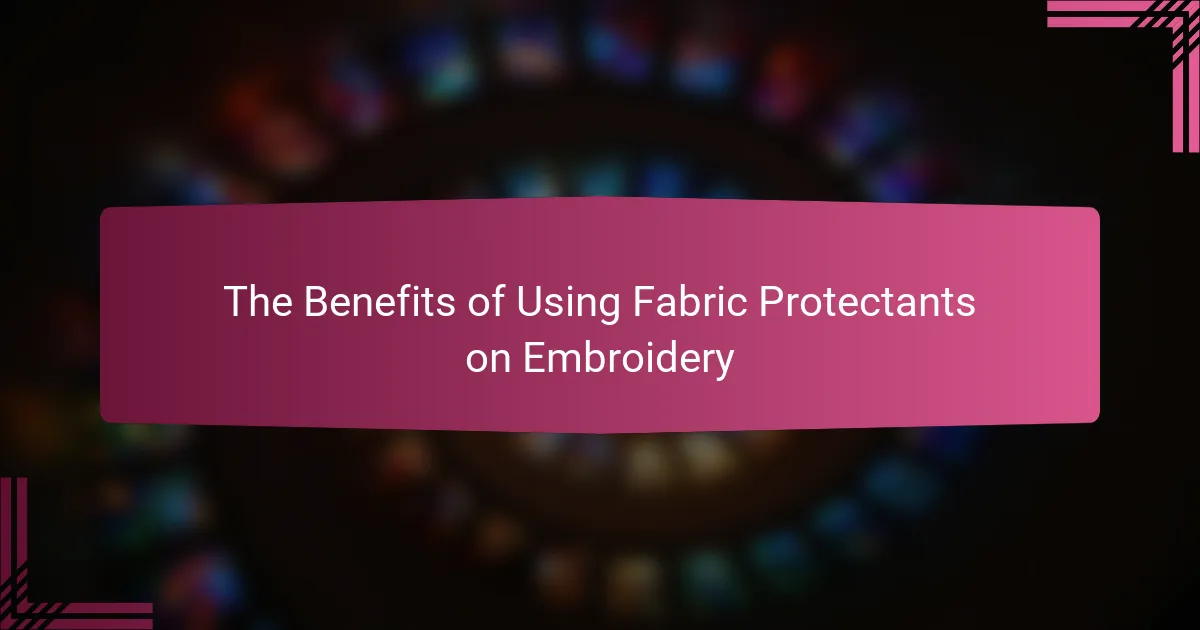
What are the benefits of using fabric protectants on embroidery?
Fabric protectants enhance the durability of embroidery. They create a barrier against stains, dirt, and moisture. This protection helps maintain the vibrancy of colors in embroidered designs. Additionally, fabric protectants reduce the risk of fading over time. They also make cleaning easier, as spills can be wiped away without damaging the embroidery. Many fabric protectants are safe for various fabrics. Their application can prolong the life of the embroidered item. Studies show that treated fabrics can resist wear and tear better than untreated ones.
How do fabric protectants enhance the longevity of embroidery?
Fabric protectants enhance the longevity of embroidery by creating a barrier against stains and moisture. This barrier prevents dirt and spills from penetrating the fabric, which can lead to discoloration or damage. Additionally, fabric protectants can reduce fading caused by UV exposure. By minimizing wear and tear from regular use, these protectants maintain the vibrancy of the embroidery. Studies show that treated fabrics can last significantly longer than untreated ones, often by several years. Therefore, using fabric protectants is a practical choice for preserving the quality of embroidered items.
What specific properties of fabric protectants contribute to durability?
Fabric protectants enhance durability through water resistance, stain repellency, and UV protection. Water resistance prevents moisture absorption, reducing fabric degradation. Stain repellency helps maintain fabric integrity by preventing dirt and spills from penetrating the fibers. UV protection minimizes fading and weakening caused by sunlight exposure. These properties collectively contribute to a longer lifespan for fabrics. Studies show that treated fabrics can last up to 50% longer than untreated counterparts.
How does the application of fabric protectants affect wear and tear?
The application of fabric protectants significantly reduces wear and tear on textiles. Fabric protectants create a barrier that repels water, dirt, and stains. This barrier minimizes friction and abrasion during regular use. Consequently, the fabric experiences less degradation over time. Studies show that treated fabrics maintain their appearance and structural integrity longer than untreated ones. For example, a study by the University of Minnesota found that fabric protectants can extend the life of upholstery by up to 50%. This demonstrates the effectiveness of these products in preserving fabric quality.
What types of fabric protectants are available for embroidery?
There are several types of fabric protectants available for embroidery. These include water repellents, stain repellents, and UV protectants. Water repellents create a barrier against moisture. Stain repellents help prevent dirt and spills from adhering to the fabric. UV protectants guard against sun damage and fading. Each type serves a specific purpose to enhance the longevity of embroidered items. These protectants can be applied as sprays or washes. They are essential for maintaining the appearance and durability of embroidered fabrics.
What are the differences between spray-on and wash-in fabric protectants?
Spray-on and wash-in fabric protectants differ in application and effectiveness. Spray-on protectants are applied directly onto the fabric surface. They create a protective layer that repels water and stains. This method allows for targeted application on specific areas. Wash-in protectants are added during the washing process. They penetrate the fabric fibers for deeper protection. This method provides an overall treatment for the entire fabric. Spray-on options may offer immediate protection, while wash-in types often require multiple washes for full effectiveness. Studies indicate that wash-in protectants can last longer through repeated laundering compared to spray-on types.
How do silicone-based protectants compare to fluoropolymer-based ones?
Silicone-based protectants offer water repellency and flexibility, while fluoropolymer-based protectants provide superior stain resistance and durability. Silicone protectants create a hydrophobic barrier, allowing fabrics to repel water effectively. In contrast, fluoropolymer protectants bond chemically to fibers, enhancing resistance to oil and water stains. Research indicates that fluoropolymer treatments can last longer under heavy use, maintaining fabric integrity better than silicone alternatives. Additionally, silicone protectants may require more frequent reapplication compared to fluoropolymer-based ones.
Why is it important to choose the right fabric protectant for embroidery?
Choosing the right fabric protectant for embroidery is crucial for preserving the quality and longevity of the embroidered design. The appropriate protectant enhances the fabric’s resistance to stains, moisture, and fading. This protection prevents damage to the intricate stitching and colors used in embroidery. Additionally, a suitable fabric protectant can improve the overall appearance of the finished product. It helps maintain the fabric’s texture and prevents wear and tear over time. Using the wrong protectant may lead to discoloration or deterioration of the embroidery. Therefore, selecting a compatible fabric protectant ensures that the embroidery remains vibrant and intact for an extended period.
What factors should be considered when selecting a fabric protectant?
When selecting a fabric protectant, consider its effectiveness against stains and spills. The protectant should form a barrier to repel liquids and dirt. Look for a product that is safe for the specific fabric type. Compatibility with the material ensures it does not cause damage. Evaluate the application method, as some products require spraying while others can be applied with a cloth. Check for durability, as some protectants last longer than others. Consider any environmental impact, opting for eco-friendly options when available. Lastly, review user testimonials for real-world effectiveness and satisfaction.
How does the type of fabric influence the choice of protectant?
The type of fabric significantly influences the choice of protectant. Different fabrics have varying levels of absorbency, durability, and texture. For instance, natural fibers like cotton and linen absorb moisture and stains more readily than synthetic fibers. This absorbency requires a protectant that can repel liquids effectively. Conversely, synthetic fabrics like polyester may need a protectant that offers UV resistance and stain repellency without altering the fabric’s texture. Additionally, delicate fabrics such as silk require a gentle protectant that does not damage the fibers. Therefore, understanding fabric characteristics is essential for selecting the appropriate protectant to enhance longevity and maintain appearance.
How do fabric protectants affect the appearance of embroidery?
Fabric protectants can enhance the appearance of embroidery by providing a protective layer. This layer helps to prevent fading and discoloration from exposure to sunlight and washing. Additionally, fabric protectants can repel stains, keeping the embroidery looking clean and vibrant. The application of protectants can also create a slight sheen, which may enhance the visual appeal of the embroidery. Studies show that treated fabrics maintain their original colors longer than untreated ones. This longevity is particularly important for intricate designs and vibrant threads. Overall, fabric protectants contribute positively to the aesthetic quality of embroidered items.
What impact do fabric protectants have on color retention?
Fabric protectants enhance color retention in textiles. They create a protective barrier that shields fibers from environmental factors. These factors include UV light, which can cause fading, and moisture, which can lead to dye running. Studies show that treated fabrics maintain their vibrancy longer than untreated ones. For instance, a study published in the Journal of Textile Science found that fabrics treated with protectants showed a 30% reduction in color fading over six months compared to untreated fabrics. This preservation of color is crucial for maintaining the aesthetic quality of embroidered items.
Can fabric protectants alter the texture of embroidered designs?
Yes, fabric protectants can alter the texture of embroidered designs. These products may create a coating on the fabric. This coating can change the feel of the embroidery. Some protectants may stiffen the material. Others might make the texture smoother or shinier. The extent of the alteration depends on the specific protectant used. It is essential to test the product on a sample before applying it to the final piece. This ensures that the desired texture is maintained.
What are the best practices for applying fabric protectants to embroidery?
Apply fabric protectants to embroidery by following these best practices. First, always pre-test the protectant on a small, inconspicuous area. This ensures compatibility with the fabric and embroidery threads. Next, clean the embroidery surface before application. Remove any dust or oils for optimal adhesion. Use a spray applicator for even coverage. Hold the spray bottle about 6-12 inches away from the fabric. Apply light, even coats to avoid saturating the material. Allow each coat to dry completely before applying additional layers. Follow the manufacturer’s instructions regarding drying times and reapplication frequency. These practices enhance the longevity and appearance of the embroidery while providing effective protection.
How can one ensure even coverage when applying fabric protectants?
To ensure even coverage when applying fabric protectants, spray from a distance of 6 to 12 inches. This distance allows for a fine mist that distributes evenly. Move the spray can in a sweeping motion across the fabric. Overlapping each pass slightly can help cover all areas. Apply in thin layers rather than a single thick coat. Thin layers dry faster and reduce the risk of pooling. Allow each layer to dry completely before applying the next. This method ensures uniform application and maximizes the protectant’s effectiveness.
What are common mistakes to avoid when using fabric protectants?
Common mistakes to avoid when using fabric protectants include not testing on a small area first. This can lead to discoloration or damage to the fabric. Another mistake is applying too much product, which can result in a sticky residue. Failing to follow the manufacturer’s instructions is also a frequent error. Each product may have specific application techniques and drying times that are crucial for effectiveness. Ignoring the need for reapplication is another oversight. Fabric protectants wear off over time and need to be reapplied for continued protection. Lastly, using fabric protectants on inappropriate materials can compromise the fabric’s integrity. Always check compatibility before application.
What troubleshooting tips are there for using fabric protectants on embroidery?
When using fabric protectants on embroidery, ensure proper application to avoid issues. Test the fabric protectant on a small, inconspicuous area first. This helps identify any adverse reactions. Apply the protectant evenly and avoid oversaturation, which can cause discoloration. Allow adequate drying time as recommended by the manufacturer. If the embroidery becomes stiff, consider using a lighter application next time. For any sticky residue, gently wash the fabric with mild soap and water. Always follow the specific instructions provided by the fabric protectant brand for best results.
The main entity of the article is fabric protectants, which are substances applied to embroidered items to enhance their durability and longevity. The article outlines the benefits of using fabric protectants, including their ability to create barriers against stains, dirt, and moisture, thereby preserving the vibrancy of colors and reducing fading over time. It discusses various types of fabric protectants, application methods, and factors to consider when selecting the right product for different fabrics. Additionally, the article addresses best practices for application, potential texture alterations, and troubleshooting tips to ensure effective use of fabric protectants on embroidery.
